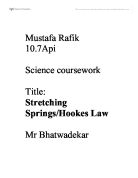Step-by-Step instructions:
- Clamp head to stand,
- Connect boss head to clamp,
- Fix one circular up to other,
- Hook weights up to the spring
- Add weights then record extensions after measuring it three times,
- Do this with eight different weights,
- Record extension from original length after finding out the average.
Apparatus:
The equipment that will be required for the testing of Hookes Law is:
- Clamp and Stand
- Weights 50grams each
- A measuring apparatus (preferably a 1 meter ruler)
- Spring
Diagram:
Fair test:
Throughout the experiment the following would be kept constant:
- The Thickness of the spring
- The length of the spring
- The material of the spring
The things that will vary throughout the experiment will be the mass and the extension. But I will only investigate and vary the mass myself because the extension will change as a cause of the mass being changed.
This test will be kept fair by applying the same weights making sure they are all 50 grams and I will place them on the spring carefully and wait till the spring has stopped moving so am accurate measurement can be made.
The most important factor I MUST use to keep this a fair test is to take accurate measurements after I measured the extension.
Method:
To undergo this experiment I will need to apply the equipment correctly and set it up the way I have shown in the diagram. I will then need to measure the length of the spring when there is no force applied, I will keep on adding 50 grams of weight onto the spring until I reach a total of 400 grams, for every 50 gram put on the extension will be recorded.
How the results will be taken:
Results table:
Analysis of graph:
Looking at my graph, I feel that my experiment has been successful. All the points are near to the line of best fit, and it shows that my prediction was correct, that EXTENTION IS PROPORTIONAL TO STRECTHING FORCE so long as the string is NOT permanently stretched.
Conclusion:
This experiment has showed that the prediction that I had made was correct. The extension will be proportional to the stretching force. Due to having foreknowledge of Hooke's Law it was easy to roughly predict what the results were going to be.
Also being aware of the movement in molecules that are found in solids was helpful. This helped me come to the conclusion that due to the amount of pressure on certain parts of the strip a wider strip would be able to withstand more pulling from the weights.
Evaluation:
The experiment managed to produce some decent, accurate results so that I was able to produce a graph and come to a good conclusion.
All of my results seemed to be very accurate. They all followed a pattern, but if I was to do it again, I would like to get to elastic point of the spring.
The only problem is that some of the measurements could have been slightly inaccurate because I was using a 30cm ruler, and maybe that spring had not fully stopped. If there were a chance to do the experiment again, I would wait longer so there’s more chance for the spring to stop.
Also to make sure that all my results were accurate I would have to dedicate more time to the experiment and be able to repeat them again.
There are many different interpretations I could of used in this experiment such as changing the length of the spring, the material of the spring or the thickness of the spring. This could all have a major effect on the final outcome of the results.







